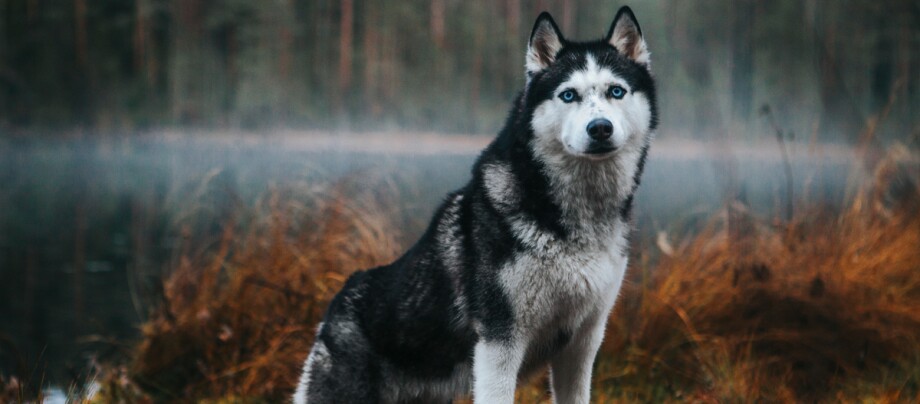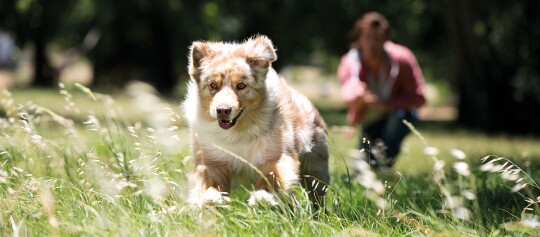Siberian Husky - Commanding, Generous and Sporty with a Heart of Gold
07.10.2022 - Reading time: 7 minutes

The Siberian Husky is a very expressive dog, which needs to be challenged both mentally and physically. If these needs are met, it proves to be a loving and loyal family dog. However, a couple of walks round the block every day will never do for this descendant from sled dogs. If you decide for a Siberian Husky you should be of a sporting disposition and also able to give your dog lots of attention.
NewsletterSiberian Husky
Breed | Siberian Husky |
Origin | Siberia |
Classification | Nordic sled dogs |
Size | Shoulder height 50 to 60 centimetres |
Weight | 16 to 28 kilograms |
Physique | slim, muscular, balanced body proportions |
Eyes | almond shaped, blue, grey, mixed colours |
Ears | narrow, set high up, triangular, medium sized, erect |
Coat and colour | sleek, thick, fleecy medium length coat; pure white to slightly coloured undercoat, top coat in all colours such as white, red, grey, balck; head area from the ears and back generally heavily coloured |
Special features | as a sled dog not particularly sensitive to the cold but sensitive to the heat, strong need for exercise |
Nature | gentle, attentive, friendly to people, loves working, intelligent |
Health | suspected susceptibility to zinc-responsive dermatosis |
We have the best products for your Siberian Husky!
Sled and working dog for thousands of years
The Siberian Husky served the Inuit for almost 2000 years as a sled and service dog. Due to the nomadic lifestyle of the Inuit people, the dog breed remained pure for a long time. At the beginning of the 20th century a fur dealer from Siberia took the powerful animals with preponderantly blue eyes to Alaska, where dog sled racing was all the rage. Thanks to their endurance, the Siberian Huskies quickly became extremely popular here. Although the breed had remained pure for centuries and displayed excellent character traits, it was only recognised in the USA in 1930 and in Europe in 1966. The FCI classified the Siberian Husky in Group 5 “Spitz and primitive type” to Section 1 “Nordic Sled Dog”. Nowadays it is still used by the Inuit as a sled dog, in the same way as the related breeds, the Alaskan Malamute and the Samoyed. However, this breed has also made a name for itself worldwide as a family dog. Thanks to its striking blue eyes and the dominantly white colour of the fur, the Siberian Husky remains a truely striking animal.
The character of the Siberian Husky
Thanks to having lived in close proximity with the Inuit people, the Siberian Husky is a dog that loves people. As a pronounced pack animal it does not like being alone. It wants to be in the thick of whatever its pack is getting up to and requires a lot of attention. In addition, it needs lots of exercise which must be satisfied. If its needs are not adequately met, the Siberian Husky will seek out its own activities, much to the annoyance of its owner. If this intelligent dog is fully occupied and well socialised, its gentle and friendly nature comes to the fore and it is a loyal companion. It is not suitable as a guard dog and its pronounced hunting instinct must be kept in check. Once it gets a scent or catches sight of quarry such as a hare, the Siberian Husky is off and is difficult to stop. An almost unique feature of the Siberian Husky is the typical howling. It hardly ever barks, but the wolf-like howl is unmistakable.
Training and husbandry of the Siberian Husky
Correct training and proper husbandry are the requirements for a successful partnership between humans and this work loving and attentive sled dog. A large house with a lot of space and a garden is ideal for them. If you wish to own a Siberian Husky, you must be sure that you have sufficient time to occupy this animal both physically and mentally. Long bike rides or runs in the countryside as well as swimming together are good ways of exercising your dog. A good mix of head work and physical exertion is ideal and will keep your Siberian Husky from getting up to mischief.
At the same time you must not leave your four-legged friend by itself for too long because, as a pack animal, it does not like to be alone. If you meet all these requirements, the Siberian Husky will be a good family dog, because well socialised animals are also friendly to children. They get on well with other dogs too. However, dogs of this breed that are under-stimulated can react towards their owners in a hostile or stubborn manner, or even ignore them altogether. Since the hunting instinct of the Siberian Husky is very pronounced, it is recommended that retrieval skills should be trained from an early age.
If you decide to own a Siberian Husky, you should be extremely aware of the this breed’s love of exercise and movement. People who work and are out of the house during the day, as well as older people and the exercise-shy, are not suitable owners for the Siberian Husky. You must be aware in advance that you are signing up to a real sporting ace with this dog, and that it needs to be challenged both mentally and physically. Good socialisation as well as training in the basic commands are essential for this intelligent dog. If all these requirements are met, you can look forward to a harmonious relationship with this companion.
Care of your Siberian Husky
The dog’s thick fur does not require any special attention unless it is moulting. When it is moulting, however, it loses fur in tufts. Brush the coat regularly and remove any dead fur. In summer it is important to ensure that the dog does not overheat, due to its thick undercoat. This breed is in its element in the winter and loves running around and playing in the iciest of conditions.
When it comes to this dog’s diet, certain things must be observed – in particular be aware that active dogs need more energy and require a balanced diet in order to keep up their vitality. But age, size and state of health also have a huge influence on diet. Always match the diet to the individual needs of the dog.
Would a Siberian Husky be right for you? What you should consider before purchase
If you love nothing more than a hot cup of tea and snuggling under a blanket on the sofa when the weather turns icy, you are absolutely not the right match for the Siberian Husky. This dog is in its element in the snow and ice. It boasts an impressive appearance but is challenging for its owner at the same time. It comes from a breed of working dogs and simply has to satisfy its urge for movement. If, instead, it is subjected to permanent sloth, the Siberian Husky can develop some atypical characteristics that manifest in different ways. It is not unusual to hear stories of owners who have been overwhelmed by the zest for action and the character of their Siberian Husky, because they chose the breed simply on looks alone. Therefore, be aware before you buy what it means to own a dog of this breed – as it loves nothing better than to be out in the wind and the rain. Therefore dog sports are a must and a good opportunity to really challenge this breed. You must acclimatise your puppy to cats from an early age, otherwise you will find its pronounced hunting instinct difficult to control.
Reputable breeders will support you with tips and advice when it comes to the diet and the typical characteristics of the Siberian Husky. Get to know the dam and sire in advance, get an impression of the breeding kennels and ask the breeder what the puppies have already been trained to do. Inoculated, chipped and healthy animals with a contract of purchase come as standard with reputable breeders. In addition, you often have the option of visiting the puppy a few times before you finally take him home with you.
Special features of the Siberian Husky
This breed is deemed to be robust and hardly susceptible to any diseases. However, it is suspected that the Siberian Husky suffers more frequently from a genetically related skin disease known as zinc-responsive dermatosis. Animals suffering from this absorb too little zinc from their food. When buying a puppy be sure to check that you are buying from a reputable and responsible breeder. You can obtain addresses of breeders from the VDH (Verband für das Deutsche Hundewesen [Germany’s Kennel club for dogs]).

